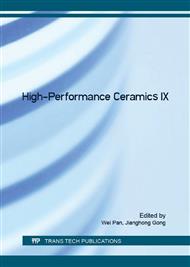p.409
p.414
p.419
p.423
p.428
p.433
p.437
p.441
p.445
Preparation and Properties of Phenolic Resin Impregnated Quartz Fiber Tile Ablative Composite
Abstract:
To improve the heat absorbed and scattered properties of quartz fiber tile, porous phenolic resin impregnated quartz fiber tile composite for ablator and thermal insulator was prepared by impregnating the quartz fiber tile with ethanol solution of phenolic resin, and then drying and cured. The phenolic resin impregnated quartz fiber tile ablative composite is a new heat protection composite material with lower density, lower heat conductivity and low mass ablation. It can be used as the widespread thermal protection system of the aero craft in the high heat flux, high temperature and extreme condition. The thermal property and ablation property of the composites were studied respectively. The ablation property of PICA was evaluated by the oxyacetylene ablation experiment. The microstructure morphology of specimen before and after ablation was viewed by SEM. The thermogravimetric analysis of the ablator was taken from room temperature to 800°C.
Info:
Periodical:
Pages:
428-432
Citation:
Online since:
July 2016
Authors:
Keywords:
Price:
Сopyright:
© 2016 Trans Tech Publications Ltd. All Rights Reserved
Share:
Citation:


